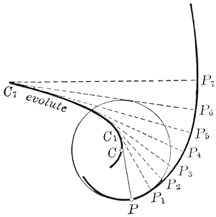Now consider the function of defined by
in which has been replaced by from (A).
Then equations (B) show that
But then, by Rolle's Theorem (§105), must vanish for some value of between and say . Therefore and are determined by the two equations
If now approaches as a limiting position, then approaches , giving
and will approach as a limiting position the center of curvature corresponding to on the curve. For if we drop the subscripts and write the last two equations in the form
it is evident that solving for and will give the same results as solving (B) and (C), § 116, for and . Hence
Theorem. The center of curvature C corresponding to a point P on a curve is the limiting position of the intersection of the normal to the curve at P with a neighboring normal.

119. Evolutes. The locus of the centers of curvature of a given curve is called the evolute of that curve. Consider the circle of curvature corresponding to a point P on a curve. If P moves along the given curve, we may suppose the corresponding circle of curvature to roll along the curve with it, its radius varying so as to be always equal to the radius of curvature of the curve at the point P. The curve described by the center of the circle is the evolute of It is instructive to make an approximate construction of the evolute of a curve by estimating (from the shape of the curve) the lengths
























